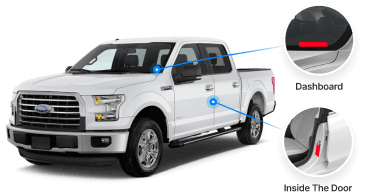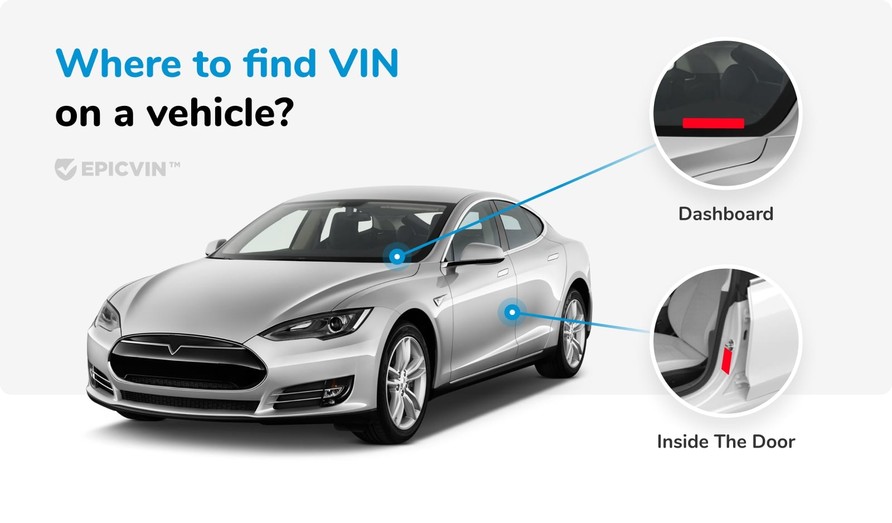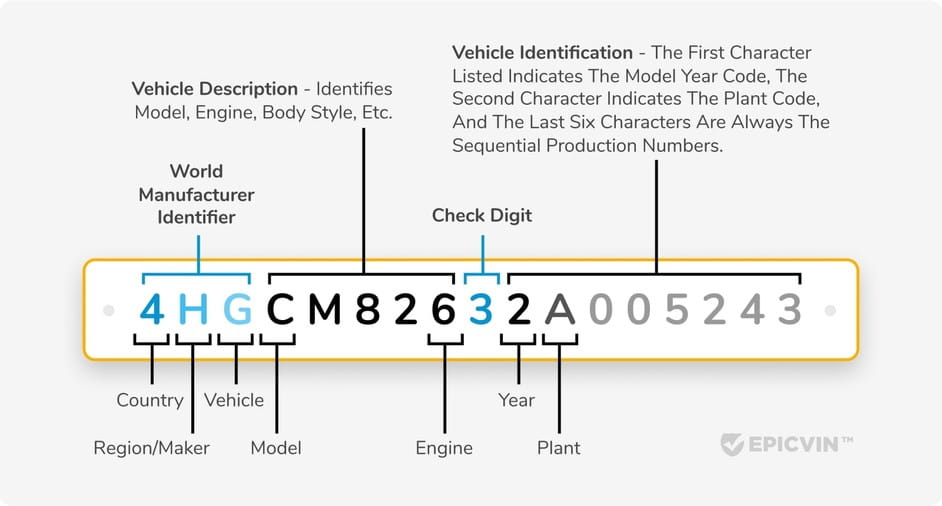
Vehicle History: Can Someone Track You Using Your License Plate?
Our team will tell you about tracking your license plate
Read moreDecode Your Vehicle Identification Number for Free. Check out some answers to common questions and get started with our VIN decoder service!
Looking for the VIN?
Here is there you’ll find it:

Do you want to learn about how a vehicle was equipped from the factory? Are you curious about where and when your car was built? If you want to learn more about a vehicle, whether it's something you own, or something you want to buy, all you need to do is use our free VIN lookup tool.
The Vehicle Identification Number is a unique code issued to every new vehicle. These codes were first used in the early 1950s to help companies identify the vehicles that came off of the assembly lines. In 1981, the National Highway Traffic Safety Administration (NHTSA) standardized the format of this code, using a 17 character format. This code does not use the letters "Q", "I" or "O" to avoid confusion with the numbers "0" and "1". The vehicle identification number includes information about where and when a vehicle was built, its configuration, and its serial number.
This code identifies more than the serial number and model. It also contains information about safety equipment, trim levels and more. This can tell you more information about a vehicle than you’ll usually get from a sales listing. Since VINs are unique to each vehicle, it’s also used to identify cars on official documents:

A VIN decoder translates the characters in the vehicle identification number into information you can use. To use this tool, all you need to do is type in the code into our website and click “Check VIN”. This will tell you information in this number, including where the vehicle was built, when it was built, what body style and engine it came with, and what major equipment was included.
It also helps uncover discrepancies in the listing. For example, let’s say you want to buy a high performance or special edition version of a particular car. While the seller may add some badges to make it look like the trim you want, it’s all but impossible to falsify the vehicle identification number. This makes it easy to check the factory information to verify the vehicle is genuine.
Each digit in the vehicle identification number has a specific meaning. Some characters are standardized across the industry, while the meanings of others change depending on the manufacturer and year. Our VIN decoder has a database of all the possible meanings of these codes. We’re constantly updating this database, so you’ll always have accurate information on the vehicles you look up. It can also identify discrepancies, such as incorrect letters and numbers.
So, let`s talk about how to decode a vehicle identification number. The easiest way to do so is to use a VIN number decoder. These services will pull all the information available about your vehicle into one simple and easy-to-read report so that you know the history of your vehicle.
VIN decoders work by pulling information from driving databases, legal records, and more. They'll be able to find out if your vehicle was involved in any accidents or if there are any thefts or other major issues associated with the car. That way, you'll be able to make an informed purchase!

Here is table simplifying the VIN:
| Vin digit | Meaning | Vin digit | Meaning |
|---|---|---|---|
| 1st digit | Country | 9th digit | Check digit |
| 2nd digit | Region | 10th digit | Year |
| 3rd digit | Vehicle Type | 11th digit | Assembly Plant |
| 4th-8th digit | Vehicle Attributes | 12th-17th digits | Sequential Number |
On most vehicles, the first three characters in the vehicle identification number are the World Manufacturer Identifier (WMI). It identifies the country where the vehicle was built, the manufacturer who built it, and the category of vehicle. For example, if you’re looking at a Chevy Malibu, the WMI may be “1G1”. “1” is one of the identifiers for American-built vehicles, “G” is for GM’s Chevrolet division, and “1” is for passenger cars. If the manufacturer makes less than 1,000 vehicles per year, the third character in the vehicle identification number is “9” and the 12th through 14th character identify the manufacturer.
The first characters of every VIN number uniquely identify the manufacturer of the vehicle. This is called the World Manufacturer identifier or WMI code.
| WMI | Region | Notes |
|---|---|---|
| A-H | Africa | AA-AH = South Africa |
| J-R | Asia |
J = Japan KL-KR = South Korea L = China MA-ME = India MF-MK = Indonesia ML-MR = Thailand MS = Myanmar PA-PE = Philippines PL-PR = Malaysia RF-RG = Taiwan |
| S-Z | Europe |
SA-SM = United Kingdom SN-ST, W = Germany SU-SZ = Poland TA-TH = Switzerland TJ-TP = Czech Republic TR-TV = Hungary TW = Portugal VA-VE = Austria VF-VR = France VS-VW = Spain VX-V2 = Yugoslavia XL-XM = The Netherlands XS-XW = USSR X3-X0 = Russia YA-YE = Belgium YF-YK = Finland YS-YW = Sweden ZA-ZR = Italy |
| 1-5 | North America |
1, 4, 5 = United States 2 = Canada 3 = Mexico |
| 6-7 | Oceania |
6A-6W = Australia 7A-7E = New Zealand |
| 8-0 | South America |
8A-8E = Argentina 8F-8J = Chile 8X-82 = Venezuela 9A-9E, 93-99 = Brazil 9F-9J = Colombia |
The fourth through eighth characters are usually used to describe the vehicle. However, unlike the WMI, this section isn’t standardized. It’s up to the automaker to determine how they want to use this character section to describe their vehicles. That said, manufacturers usually encode most of this information in the VDS:
The 9th digit is the check digit. This is generated using a mathematical formula that uses several characters from the rest of the code.
The Vehicle Identifier Section (VIS) covers the rest of the vehicle identification number, starting at the tenth character.
The tenth character is the year the vehicle was built. There are 30 numbers and letters used for this code: numbers 1-9 and letters A-Z, excluding “I”, “O”, “Q”, “U” and “Z”. Numbers 1-9 were last used from 2001-2009, while 2023 models use the letter “N”.
The eleventh character is the assembly plant. It’s up to the manufacturer to determine which code they want to use for each of their plants.
The twelfth through seventeenth characters are the serial number, also called the sequential number. This is usually issued in the order vehicles come off the assembly line. However, the manufacturer may skip numbers to separate major changes within a model year.
| Code | Year | Code | Year | Code | Year | Code | Year |
|---|---|---|---|---|---|---|---|
| A | 1980 | L | 1990 | Y | 2000 | A | 2010 |
| B | 1981 | M | 1991 | 1 | 2001 | B | 2011 |
| C | 1982 | N | 1992 | 2 | 2002 | C | 2012 |
| D | 1983 | P | 1993 | 3 | 2003 | D | 2013 |
| E | 1984 | R | 1994 | 4 | 2004 | E | 2014 |
| F | 1985 | S | 1995 | 5 | 2005 | F | 2015 |
| G | 1986 | T | 1996 | 6 | 2006 | G | 2016 |
| H | 1987 | V | 1997 | 7 | 2007 | H | 2017 |
| J | 1988 | W | 1998 | 8 | 2008 | J | 2018 |
| K | 1989 | X | 1999 | 9 | 2009 | K | 2019 |
What can you learn when you use our site to decode a vehicle identification number? This code contains unique letters and numbers, each with their own meaning. This information is useful for identifying and categorizing vehicles. Looking for a new car? You can use it to see what equipment the vehicle came with at the factory. Need to repair your current vehicle? This information can help you order the correct parts. Here are a few examples of these numbers, and what you can learn from them when you decode them.
First, enter the vehicle identification number of the vehicle into the search bar. When you click “Check VIN”, our site will decode the number. It will tell you information about the car issued at the factory. This includes the model, year, manufacturing location, and equipment. It also tells you if the vehicle was in an accident or if there are any vehicle recalls.
Using epicvin.com to decode a vehicle identification number is easy:
You’ll be sent to a page with all the information contained in the vehicle identification number. Want to know more about a vehicle? Order a VIN report. This looks into official databases, building a history of the vehicle, including previous accidents, police reports and other legal issues.
Vehicle Owner Lookup
RV VIN Lookup
DMV VIN Check
Title Check
Motorcycle VIN Check
Locations vary from manufacturer to manufacturer. However, there are three places you can find the code on most vehicles:
- Look through the windshield at the dashboard. On the driver’s side, you should see a small metal plate with the number stamped into it.
- Open the driver’s door. Look at the front and side of the door pillar for an I.D. sticker. It usually has the manufacturer’s logo on it. The code should be on this sticker.
- Open the hood. You may see a sticker on the firewall or near the passenger’s side strut tower. Some cars have the number engraved in one of these areas.
Since this number is used to identify the vehicle on official documents, you can also find it on the title, the window sticker, and on insurance policies.
We also decode numbers for RVs, heavy-duty trucks and motorcycles. If you need to decode an RV number, make sure it’s the one issued by the chassis manufacturer, not the RV outfitter.
No. Canadian and Mexican cars usually use the same format. Other countries use their own formats.
It’s up to the manufacturer to determine what they want to include for some parts of the number. For example, some companies don’t include information about transmissions or trim levels.
Usually, no. A few manufacturers stamp the code into the engine. If the VINs on the engine and car match, then it’s the original engine. On most vehicles, there isn’t anything that ties an engine to a specific vehicle. At most, looking up the vehicle on our website will tell you if a different type of engine was installed. For example, if someone swaps a V8 into a Ford Mustang, our site will tell you it originally came with a V6.
Discover expert tips, news and advice on buying and maintaining used vehicles

Our team will tell you about tracking your license plate
Read more
Here we will tell you how to make an older car safer to drive.
Read more
Check out how to find out the vehicle history by the old license plate
Read more